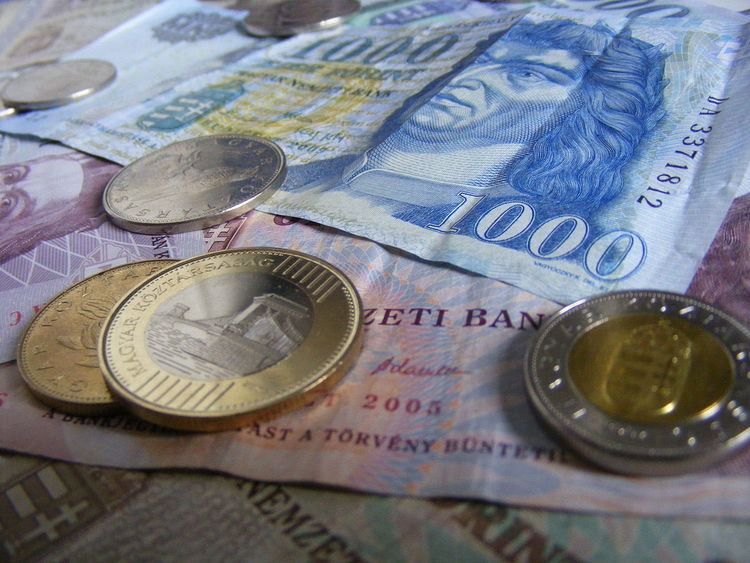Code HUF Plural not used | Symbol Ft | |
 | ||
Banknotes 500 Ft, 1000 Ft, 2000 Ft, 5000 Ft, 10,000 Ft, 20,000 Ft Coins 5 Ft, 10 Ft, 20 Ft, 50 Ft, 100 Ft, 200 Ft | ||
The forint (sign: Ft; code: HUF) is the currency of Hungary. It is divided into 100 fillér, although fillér coins are no longer in circulation. The introduction of the forint on 1 August 1946 was a crucial step of the post-World War II stabilization of the Hungarian economy, and the currency remained relatively stable until the 1980s. Transition to market economy in the early 1990s deteriorated the value of the forint; inflation peaked at 35% in 1991. Since 2001, inflation is single digit and the forint was declared fully convertible. As a member of the European Union, the long term aim of the Hungarian government may be to replace the forint with the euro but that does not appear to be likely until some time during the 2020s.
Contents
History
The forint's name comes from the city of Florence, where golden coins were minted from 1252 called fiorino d'oro. In Hungary, florentinus (later forint), also a gold-based currency, was used from 1325 under Charles Robert and several other countries followed its example.
Between 1868 and 1892 the forint was the name used in Hungarian for the currency of the Austro-Hungarian Empire, known in German as the gulden or florin. It was subdivided into 100 krajczár (krajcár in modern Hungarian).
The forint was reintroduced on 1 August 1946, after the pengő was rendered almost worthless by massive hyperinflation in 1945–46—the highest ever recorded. The process was managed by the Hungarian Communist Party, which held the relevant cabinet seats. The forint's success was exploited for political gains, contributing to the Communists' takeover of complete power in 1948–49. The forint replaced the pengő at the rate of 1 forint = 4×1029 pengő—dropping 29 zeroes from the old currency. In fact, this was an imaginary exchange rate. With the highest value note being 100 million B. pengő (1020 pengő), the total amount of pengő in circulation had a value of less than 0.1 fillér. Of more significance was the exchange rate to the adópengő of 1 forint = 200 million adópengő.
Historically the forint was subdivided into 100 fillér (comparable to a penny), although fillér coins have been rendered useless by inflation and have not been in circulation since 1999. (Since 2000, one forint has typically been worth about half a US cent or slightly less.) The Hungarian abbreviation for forint is Ft, which is written after the number with a space between. The name fillér, the subdivision of all Hungarian currencies since 1925, comes from the German word Heller. The abbreviation for the fillér is f, written also after the number with a space in between.
After its 1946 introduction, the forint remained stable for several years, but started to lose its purchasing power as the state-socialist economic system lost its competitiveness during the 1970s and 1980s. After the democratic change of 1989–90, the forint saw yearly inflation figures of app. 35% for three years, but significant market economy reforms helped stabilize it. Since year 2000 the relatively high value of forint (especially compared to the falling US dollar and to some extent to the euro) handicaps the strongly export-oriented Hungarian industry against foreign competitors with lower valued currencies.
Coins
In 1946, coins were introduced in denominations of 2, 10, 20 fillérs and 1, 2, 5 forints. The silver 5 forint was reissued only in the next year, later it was withdrawn from circulation. 5 and 50 fillérs coins were issued in 1948. In 1967, a 5 forint coin was reintroduced, followed by a 10 forint in 1971 and 20 forint in 1982.
In 1992, a new series of coins was introduced in denominations of 1, 2, 5, 10, 20, 50, 100 and (a somewhat different, 500‰ silver) 200 forint. Production of the 2 and 5 fillér coins ceased in 1992, with all fillér coins withdrawn from circulation by 1999. From 1996, a bicolor 100 forint coin was minted to replace the 1992 version, since the latter was considered too big and ugly, and could be easily mistaken for the 20 forint coin.
Silver 200 forint coins were withdrawn in 1998 (due to their nominal value getting too low compared to their precious metal content), the 1 and 2 forint coins remained in circulation until 29 February 2008. The sum of total purchases is rounded to the nearest 5 forint (to 0 or to 5) when paid with cash. A new 200 forint coin made of base metal alloy was introduced in place of the 200 forint bank note on 15 June 2009.
